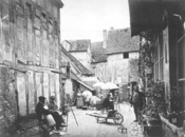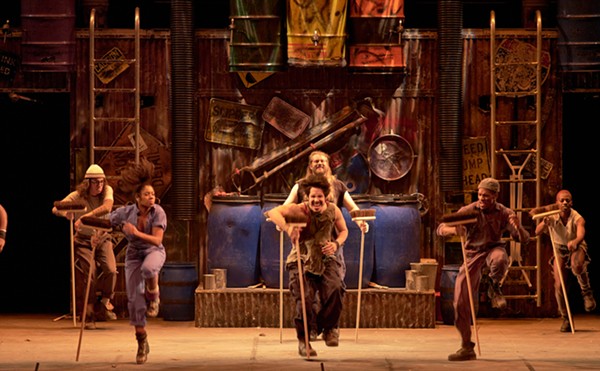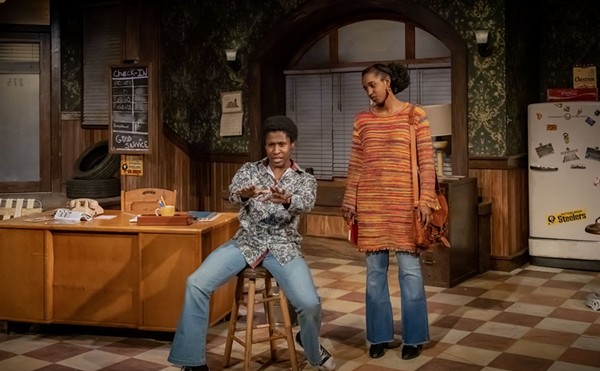Visitors desiring to see 19th-Century French Portrait Photography, an excellent new exhibit at the Cleveland Museum of Art which consists of 22 works culled from the museum's extensive permanent collection, will not have to put up with such inconveniences. Indeed, painting and photography are compatriots, not arch rivals, at the museum this summer. CMA's decision to accompany its outstanding Faces of Impressionism show with these photographic portraits serves to emphasize the cross-fertilization that took place in French artistic life during the mid-19th century. The emergence of photography, tradition-bound academy officials notwithstanding, had an impact on painting, and painting, in turn, influenced photography. The old stereotype, about artists being so totally absorbed in their own vision that they disregard everything their colleagues do, gets a healthy reality check in this show.
Take, for instance, a photo called "Courtyard With Painters." What initially strikes us is the raw factual inventory. It's as though this unknown photographer in the late 1860s decided to record this scene so that he could catalog the items in it: sloping roofs, wood wheelbarrow, woman washing clothes, artists painting pictures, parasols, an innkeeper staring out at us, the ivy-covered building from which he has emerged, and the cobblestone pavement on which he stands. This scene of 19th-century rustic life gets its strength simply through the brute accumulation of detail. One has a sense of life passing quickly by, as though the stern innkeeper with the prominent sideburns at far right will soon turn away, go back into his place of business, and chat with the chef about that evening's menu.
This sense of reality caught on the fly was also a prominent feature in contemporaneous works by artists like Claude Monet and Edgar Degas. In the Faces of Impressionism show nearby, one can see these impulses at work in paintings like Édouard Manet's "The Monet Family in Their Garden at Argenteuil." In this 1874 oil, we see the same concern for recording concrete details: Monet's watering can, a rooster, a duck, Camille Monet's red fan, her pensive expression as she sits on the grass with closed fist placed under chin. Here is an instance of a painter who achieves a photograph's specification of detail. It is clear that Manet was aware of photographs such as "Courtyard With Painters" and that he was able to modify its themes for his own purposes.
Did painting, on the other hand, influence portrait photography? Certainly. In fact, in this show, one sometimes senses these artists responding creatively to time-tested formulas. Jean-Auguste-Dominique Ingres's portrait of Monsieur Louis-François Bertin, a painting of 1832, presents the founder of an influential journal against a neutral backdrop. Bertin leans slightly forward in his chair and sets his hands on his knees. His expression is a self-confident scowl, and his fingers suggest both claws and the roots of a tree. This man is an enigma: Is he like some predatory bird, or is he a pillar of strength in the community? Ingres keeps us guessing. Even Bertin's face seems to reflect a divided personality. The right half is crimson, heavily lined, and strangely ominous, while the left half is comparatively serene. One recalls how many commentators point to the startling difference between the left and right halves of Edgar Allan Poe's face -- is it possible to read nuances of character in such differences? Ingres puts the question out on the table, but he doesn't answer it. He interprets Bertin by drawing attention to his facial characteristics and his body language. But viewers are also given latitude to draw their own conclusions.
Photographers included here, such as Nadar (who, perhaps ahead of his time, insisted on going by one name) and Étienne Carjat, put their own stamp on such traditions. Nadar, one of the best known of all 19th-century French portraitists, is represented in the show by "Alexandre Dumas Père" (1855). It shows the author of The Three Musketeers and The Count of Monte Cristo staring out at us. He is in good spirits, and there is a hint of mischief in the laughing eyes. In fact, one suspects that, if this weren't supposed to be a formal portrait, Dumas would have laughed heartily. Nadar thus retains the spare trappings of a formal portrait (as Ingres did in his portrait of Monsieur Bertin), but punctures the solemnity of the occasion by showing his sitter chuckling underneath his mustache.
Carjat's "Sarah Bernhardt in "Zaire' by Voltaire" (1874) depicts the famous French actress dressed for one of her exotic roles, and here we go back to one of the principal attractions of photography. Tom Hinson, curator of contemporary art and photography at the museum and the organizer of this show, remarks that the "early allure [of photography] lay in its ability to quickly, precisely, and economically capture a likeness." As 21st-century viewers, we must remember that we have become jaded to the thrill of seeing a familiar public figure captured on film. For example, we would probably yawn if shown pictures of Bill Clinton as he delivered his first inaugural address. By contrast, to a late 19th-century audience who had recently seen Sarah Bernhardt onstage, a portrait like this would have been a precious reminder of both her appearance and her acting ability. Here, in fact, is an explicit instance when painting and photography worked together. Photographers satisfied the public's need for a quick likeness of Bernhardt, while painters concentrated on the task of interpreting her inner character.
But as scholar Leo Braudy has pointed out, there was also a dark underside to this relationship. Says Braudy: "Matthew Brady [the great Civil War photographer] considered his work to be the raw material from which painters and other "serious' artists could work." In other words, there was a lot of "cultural intimidation" in the air: Some painters and academic traditionalists saw value in the new medium as long as it remained subservient. Unfortunately, talented artists like Brady bought into this kind of thinking and misjudged their own abilities. We see some of that in this show, too. For example, "Study After Nature" (1853-'55) is photographer Julien Vallou de Villeneuve's portrait of a semi-nude model. He created it as part of a series: a repertoire of poses that artists then used as compositional aids. Artists like the French realist Gustave Courbet would thus be able to refer to a photo like this in lieu of hiring a model. The poignant thing is that de Villeneuve's photo transcends the purpose for which it was designed. The model stares out at the viewer forlornly, and the atmosphere of gentle melancholy is well-caught. This may be a study, but it is also vital and real. In fact, one doubts whether a painting could as effectively capture the mixture of raw description and finely turned emotion of this shot.
One leaves this exhibit marveling at the degree to which early French portrait photographers were tuned in to what was happening around them, both in the artistic world and in the world at large. The aforementioned "Courtyard With Painters," for example, is an extraordinarily vivid slice of 19th-century French life. The stuffy self-important innkeeper with the beard and sideburns reminds one of Vincent Van Gogh's 1888 portrait of his friend Roulin the postman. Roulin, in his blue postman's uniform, and the innkeeper proudly standing next to his inn share the same facial characteristics, but more important, they are both of a particular type. They are solid, bourgeois citizens who take pride in what they do and have a vested interest in obeying authority.
The German photographer August Sander, during the late 1920s, shot a remarkable series of such bourgeois types in his own country: solid innkeepers and haughty pastry chefs among them. Sander was tacitly suggesting that the complacency of such people was leading Germany in a dangerous direction. The 19th-century French works do not contain prophetic warnings, but perhaps inadvertently, they ruthlessly dissect the pretensions of the middle class. That's yet another layer in this multifaceted show.
This exhibit provides a rare peek into the origins of photography and into the dynamics of 19th-century French life. Those early photographers had a rough time with the academic establishment, but this show proves that their artistic impulses were sure and their knowledge of life was vast.













